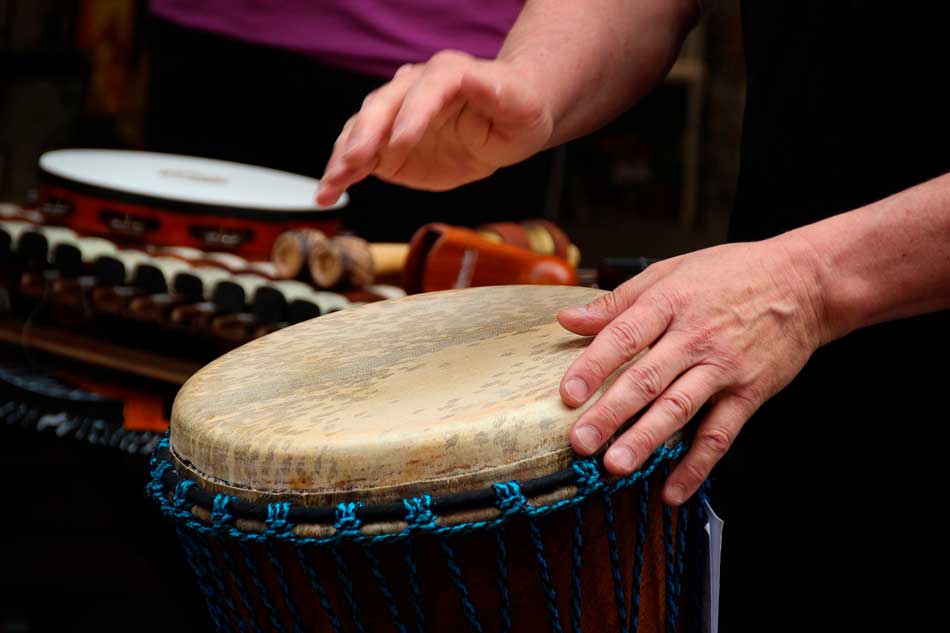Rhythm and Language
Have you ever been aware of the rhythm you use when speaking?
Rhythm is the fundamental basis for using language; daily use in conversation reveals an important pattern in the skills that one has.

Rhythm is the fundamental basis for using language; daily use in conversation reveals an important pattern in the skills that one has.


We have in Spanish ritmo, don't say in English rhythm, how about in French rytm, or Russian pumm, Japanese rizumu. Do you see any difference? Perhaps one way to tell if something different exists is to start a conversation, konversation, conversation, or conversation. Of course doing so will show us quite a few differences, but the languages of the whole world can share a lot, as shown in these words. For thousands of years we have sung, clapped, danced, played percussion instruments, and talked to the beat. Just as our bodies have evolved, language has also evolved at a much faster rate than our bodies. The question we ask ourselves, are linguistic rhythmic patterns really universal? At the University of Oxford, a study compared the rhythms of Russian, French, Greek, Mandarin and English, the results were surprising, the languages did not present dramatically different rhythms. What makes them different comes more from the speakers than from the rules of the language itself. Probably with these investigations one could consider the Theory of Universal Grammar by Noam Chomsky, which says that we are all programmed in some way to make sentences, perhaps everything has to do with the weight of each syllable.
If we stop to analyze the words, we see that rhythms are used in the syllables, in which some are accentuated and others are not, of course, they can be complex if we analyze them carefully, although we use them unconsciously. One of the first rhythms we hear is the heartbeat of our mothers when we are in their womb, its rhythmic pattern is described as not accented, it is presented as a short one followed by a longer one: the iambic meter, five repetitions of this, is known as iambic pentameter, used in the construction of Shakespeare's blocks. There are more variants such as trochaic or anapestic, long-short the first and short-short-long the second, these derive from Latin and Greek which dominate in English if not also in other languages of Europe .
Accentuation patterns occur in the speech and songs of everyday life, not just in higher literature. Having a rhythm in the songs is very important, in English and in other languages the rules can be complex, we have an example in the song The ticket perforator, where the author uses the iambic measure to show ironically the repetition of the ticket puncher job. There are many songs that are using the rhythmic meters in a concert, making the lyrics more complex, such is the case of hip-hop. In classical music it is not the exception, in this genre the combination of different rhythms and accents is very variable that it is difficult to analyze it, some are more feasible to analyze and do not require more knowledge than life everyday life, as is the case with this work by L. Anderson The typewriter, which shows with a series of rhythms, a fun way and with irony what someone who works in an office.
Combining the natural rhythm of words with the music itself has been shown to help improve language skills. The smallest of the home who learn through rhythm, as a reptilian method, is often the key to learning other languages, this has been shown by Northwestern University of Chicago.
At the school of Music and English from the academy Classic and Sacrum of the face-to-face students, the music reading teacher deliberately misleads the students by mixing sentences, putting accents on other syllables To show them how the meaning of music can be changed as with words, those who are learning a language are reminded to emphasize certain accents, or certain words, as in these classes for Spanish speakers, the important accents of English are highlighted.
Will there be cultural differences to use rhythm in languages? There is a study that shows incredible differences in how the rhythm is perceived, a series of long and short rhythms were played to a group of Japanese and a group of American English speakers, the Americans identified it as short-long (iambic), but the Japanese speakers perceived it as long-short, a test was applied with sounds at different volumes, both coincided in high and low, showing that different cultures use and perceive language through rhythm.
Cultures can be very varied, the ideas of each country may not coincide, but something that is shared is the need to communicate.